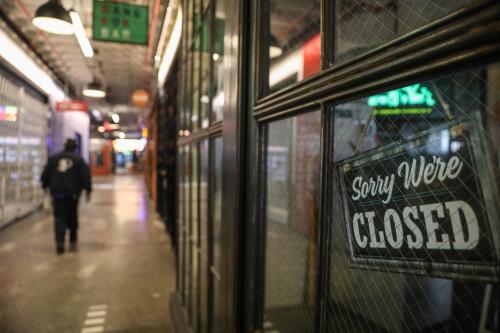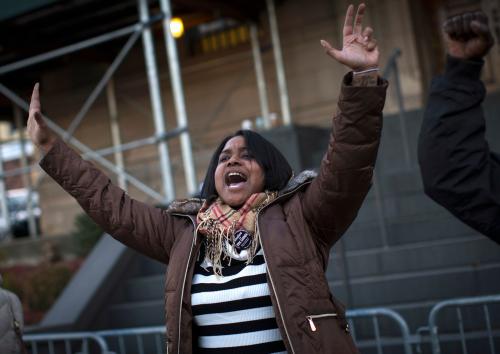If you want more content like this, subscribe to our newsletter.
This week in Class Notes:
-
- Access to public four-year colleges in Georgia dramatically increases students’ B.A. completion rates and incomes around age 30, with students from low-income high schools benefiting the most.
- Pattern-or-practice investigations that were preceded by viral incidents of deadly force by police officers led to large increases in homicides and total crime – causing almost 900 excess homicides and 34,000 excess felonies.
- Wealth serves as “collateral” that can strengthen a marriage contract.
- Our top chart shows that students from the top quintile are significantly more likely than both bottom quintile and middle-class students of similar levels of academic achievement to attend Ivy League universities.
- Nicholas Kristof describes the dangers of systemic racism.
- Finally, check out Hannah Van Drie and Richard Reeves’ new piece “Many essential workers are in ‘low-prestige’ jobs. Time to change our attitudes – and policies?“
The economic impact of access to public 4-year colleges
To what extent do public colleges and universities improve economic mobility? Two-thirds of U.S. college students seeking bachelor’s degrees enroll in public four-year colleges and universities, yet we have surprisingly little causal evidence on whether access to this sector improves students’ economic trajectories. Smith et al. address this need by estimating the economic impacts of students’ access to the University System of Georgia. Their results show that enrollment dramatically increases students’ B.A. completion rates and raises their incomes around age 30 by 20% on average. Students from low-income high schools see a 40% increase in income. Access to this sector has no clear impact on student loan balances or other measures of financial health. However, for the marginal student, enrollment has large private returns in the short run and positive returns to state budgets in the long run.
Policing the police: The impact of ‘pattern-or-practice’ investigations on crime
Police use of force has become one of the most important and divisive social issues of our time. Recent recordings of excessive force have led to a wave of nationwide protests and a national discussion on race and policing in America. A key tool the government uses to combat unconstitutional policing is called a “pattern-or-practice” investigation. Devi et al. provide the first empirical examination of the impact of federal and state “pattern-or-practice” investigations on crime and policing. The authors find that the incident that sparks an investigation is an important determinant of how the investigation will impact policing and crime. For investigations that were not preceded by viral incidents of deadly force – those that receive widespread media attention – investigations caused a significant decline in homicide and total crime rates. In contrast, investigations that were preceded by viral incidents of deadly force led to large increases in homicides and total crime – causing almost 900 excess homicides and 34,000 excess felonies. These trends may be a consequence of abrupt changes in the quantity of policing activity following an investigation.
Collateralized marriage
Marriage has declined as the central organizing structure of the American family. As more individuals choose non-marital fertility, one might wonder whether marriage is too strong a contract, leaving people seeking a weaker alternative. Yet marriage rates have remained persistently higher for wealthy individuals, even after accounting for factors like education, income, and race. Lafortune et al. present a theoretical argument and empirical evidence that wealth serves as “collateral” to strengthen the marriage contract, and that this “collateralized” contract had retained its value even as the value of marriage has otherwise eroded. In particular, because the marriage contract states that joint assets are to be divided in the case of divorce, the authors suggest that wealth allows a couple to commit to more equal sharing of assets in case their union dissolves. This provides protection to the partner who does more “at-home” work. Consequently, couples with “collateralized” marriages are able to choose the optimal division of “at-home” and “traditional” labor and receive more value from marriage. This has the important policy implication that wealth inequality may directly lead to inequality in family structure, child investments, and other important outcomes.
Top chart
This week’s top chart shows that, among students with the median SAT score required by Ivy League universities, those from the top quintile are significantly more likely than those from the bottom quintile – and particularly the middle class – to end up attending these schools. This chart was produced by John Friedman for our May 19th webinar on college access, admissions, and the American middle class. The research produced by the Future of the Middle Class Initiative that motivated the event can be found here.

Choice opinion
“There is another kind of violence, slower but just as deadly, destructive as the shot or the bomb in the night. This is the violence of institutions; indifference and inaction and slow decay. This is the violence that afflicts the poor, that poisons relations between men because their skin has different colors. This is a slow destruction of a child by hunger, and schools without books, and homes without heat … structural racism doesn’t easily go viral, but it is deadly,” writes Nicholas Kristof in the New York Times.
Self-promotion
The COVID-19 pandemic has underscored the importance of many workers in “low-prestige” jobs in our food supply chains, transportation networks, and elsewhere. These workers are disproportionately Black and Hispanic. Many are immigrants, and some are undocumented. Their jobs lack many of the benefits and protections of “high-prestige” positions. Very often, these workers feel ignored and disrespected. In their new piece “Many essential workers are in ‘low-prestige’ jobs. Time to change our attitudes – and policies?“, Hannah Van Drie and Richard Reeves use data from the General Social Survey to examine the perceived occupational prestige of many of these essential workers. Quotes from these workers are also included to give us an inside look at the experiences of these heroes.
The Brookings Institution is committed to quality, independence, and impact.
We are supported by a diverse array of funders. In line with our values and policies, each Brookings publication represents the sole views of its author(s).








Commentary
Class Notes: Policing the police, college access, and more
Wednesday, June 17, 2020